Gigabyte H55N-USB3 : Mini-ITX done the Gigabyte way...
by Rajinder Gill on June 15, 2010 7:49 AM EST- Posted in
- Motherboards
- Intel
- Gigabyte
- Mini ITX
We start with the same old "swings and roundabouts" in performance figures that you’ll never notice in real world usage:
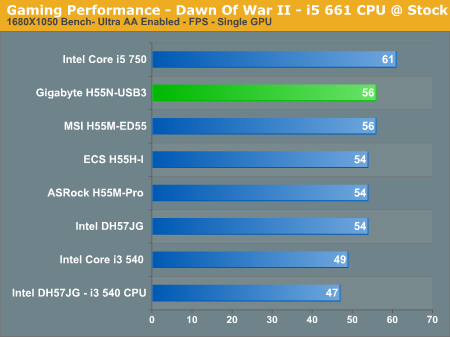
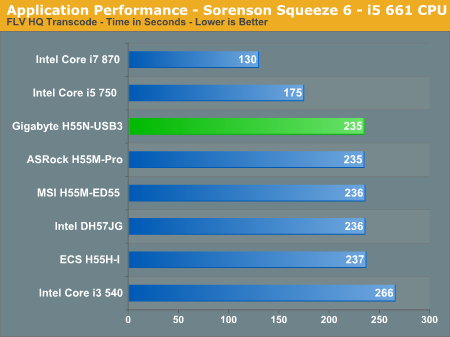
Power Consumption
Our power consumption testing utilizes the same batch of components under similar circumstances in a bid to monitor variances between idle and CPU load conditions. We install the vendor supplied power saving utilities on each board and enable power saving modes that don't involve any kind of underclocking or CPU core frequency modulation in order to run an apples to apples comparison.
ATX PSU switching losses are absent from our figures because we monitor power consumption directly at the DC rails of the PSU. These figures measure only the CPU, motherboard and memory DC power draw and exclude any other peripherals, such as cooling fans and hard drives etc. Actual AC power consumption for the motherboard will be anywhere from 15~40% higher than these figures depending upon the efficiency of your power supply.
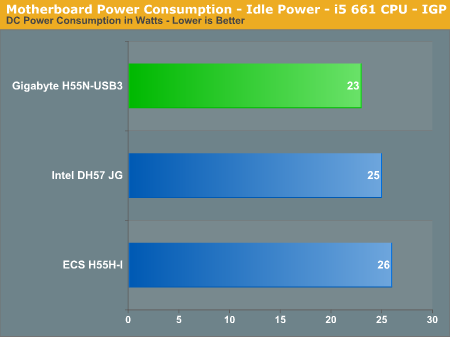
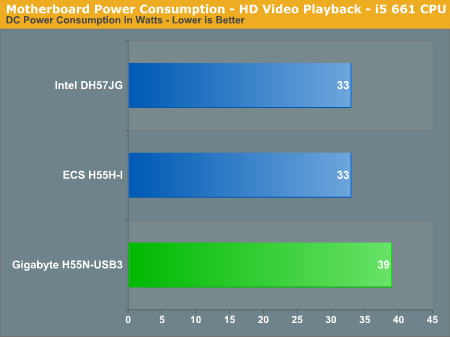
The H55N-USB3's idle power consumption is excellent, although you lose out on efficiency under load compared to boards from Intel and ECS.
Overclocking
Using the stock Intel cooler with our 661 sample, we managed achieve around 4.2GHz Linpack stable:
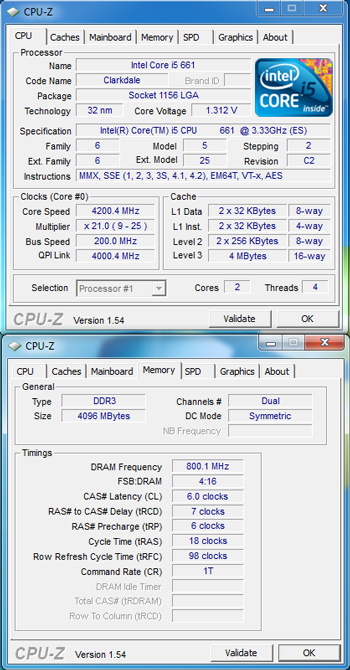
The Clarkdale IMC isn’t ideally suited to high memory bandwidth, so we settled for a perfectly respectable DDR3-1640 with CAS 6-7-6-18 timings using our high-end Corsair Dominator kit whilst keeping QPI and CPU frequency in sync. This overclock was held stable by using 1.31Vcore (load voltage is likely a lot less as we kept Vdroop enabled), a set VTT of 1.31V and VDIMM of 1.65V.
Pushing higher than this would be possible with improved processor cooling, but as a side-effect requires more VTT if QPI and memory frequency is not relaxed - and we’re already setting 1.31V which seems to be the upper limit of what the VTT VRM can handle. Setting a higher voltage results in the board shutting down during Linpack, which confirms OCP does work on this particular rail.
We also checked out possibilities with a Lynnfield, using our 875-K sample to see what the board can handle:
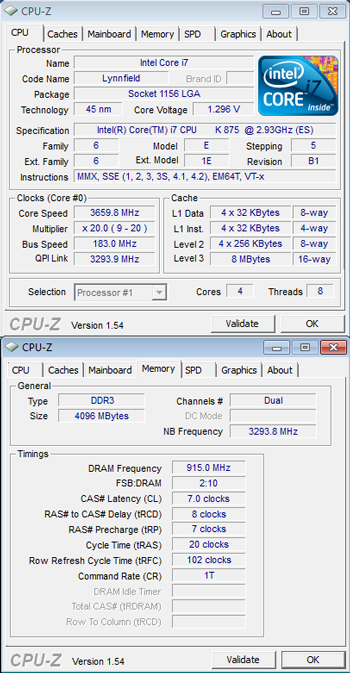
3.66GHz is the upper level of what is achievable during Linpack with a HT enabled i7 processor. It’s not the greatest overclock, but is better than what some of the other H55 mini-TX boards can manage and is competitive with DFI’s MI-T36, aside from it being easier to cool the processor on the latter due to a better layout. Out of interest, we did attempt multiplier only overclocking too, but found that same overall CPU clock speed limit – any higher and the board shuts down during Linpack.
Should you opt for an i5-750 Lynnfield, CPU speeds up to 3.8GHz should be sustainable, provided you can find a way to keep the CPU cool enough under heavy loads.










77 Comments
View All Comments
mongoosesRawesome - Wednesday, June 16, 2010 - link
use the integrated graphics (freeing up the PCIe) and a USB for the wireless. Or use a USB TV tuner with USB wireless, and then use whatever graphics you want. If you need extra expansion, mini-itx isn't for you.Barnaby W. Füi - Wednesday, June 16, 2010 - link
Newegg shows this board as using the Realtek 8111E LAN chipset. Doesn't the H55 already include gigabit LAN? Why wouldn't they use that?Taft12 - Wednesday, June 16, 2010 - link
Nearly all H55 motherboards use that crummy Realtek chip and it must be even cheaper than wiring up the integrated Intel networkRajinder Gill - Thursday, June 17, 2010 - link
I hear the Intel NIC costs as much on it's own to implement, as it does to buy the Realtek audio and LAN ICs as a pair (price break and volume purchase incentives). There's your reason.-Raja
pectin232 - Monday, September 20, 2010 - link
Raja can you help with BIOS settings for this board. I truly appreciate. I have the same board with the i7 860 instead of the 865. I got 8GB DDR3 1333 memory from G.SKILL Ripjaws Series 8GB (2 x 4GB) 240-Pin DDR3 SDRAM DDR3 1333 (PC3 10666) Desktop Memory Model F3-10666CL9D-8GBRL. Any help is truly appreciate.Phillip
Folterknecht - Wednesday, June 16, 2010 - link
This cooler will likely fit in any HTPC-Case and there should be no problems with backplates and parts of the motherboars "connecting". the review is german but numbers and pictures should do the job. Note that you can also mount a slim (12mm) 120mm fan on top of it.http://extreme.pcgameshardware.de/luftkuehlung/105...
I'm not sure if this cooler is available in the U.S.
Khenke - Wednesday, June 16, 2010 - link
If the end of the CPU to the graphics card is more than 27mm then it will most likely fit perfectly and with a 120 mm fan it will even cool the RAMs.As specs tell here: http://www.prolimatech.com/products/cpu_cooler/sam...
fr500 - Wednesday, June 16, 2010 - link
Do you think this board is a "safer" overclocker than DFI MI P55-T36? I have had 4 of those boards (2 for customers one for a friend and one for me)I did extended testing on my customer's PCs and everything went fine. My friend let the board overclock by itself via ABS II and it's board died after just one day. Had to RMA. Many people reported the same issue and I guess they addressed it with BIOS updates.
Does it need active cooling for the power circuitry? Inside my SG05 the DFI board needs a bit more airflow than the 120mm fan on front can provide. My build has an i5 750@150BCLK with 1.1v and the phases would get to 90c without active cooling. I had to add an 80mm slim fan from an old sff PSU to get temps on the safe side.
To sum up. Is it better auto protecting itself if you push too far? (DFI board pushes too far by itself via ABS) and, does it need active cooling for the power circuitry?
Rajinder Gill - Wednesday, June 16, 2010 - link
Hi,In my testing so far, the H55N-USB3 has better over-current protection. I've killed one DFI board just by booting it at 180 BCLK with an 870 oon the initial launch BIOS. Whether or not what I've found with teh H55N-USB3 will apply to all cases though I cannot say, as these things can be random. I did make a suggestion to Gigabyte to lock things down for the quad cores, and they told me they would look into what they feel is safe.
A bit of airflow across the VRM won't hurt things if you want to keep temps low (although this has nothing to do with OCP per se). If I were running any one of these boards long term, I would probably keep myself to a 3.6GHz cap on the quads.
-Raja
fr500 - Wednesday, June 16, 2010 - link
Yes that is the same thing i saw with the DFI on the shipping BIOS, after that i lost my confidence.Thanks a lot it's reassuring.
I think you could mount the H50 safely with 2 washers (included with the H50) on each hole by the way.